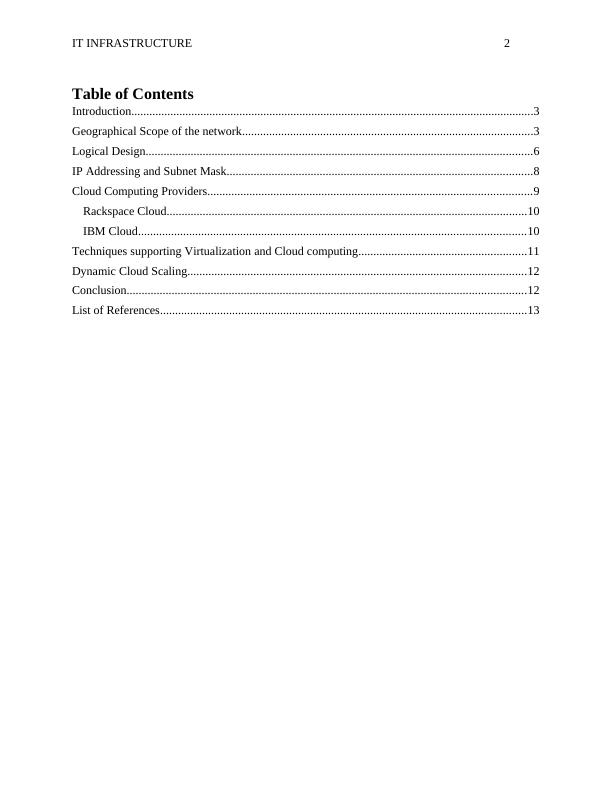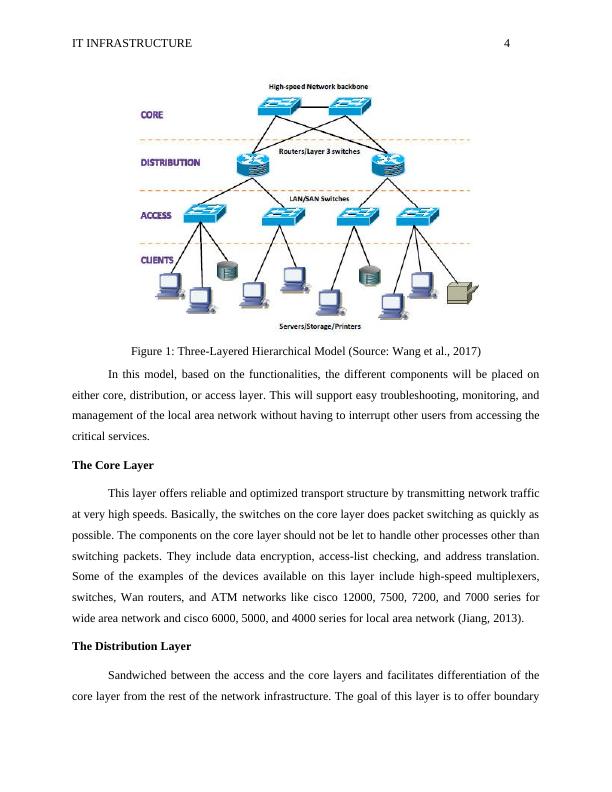IT Infrastructure: Network Design and Cloud Computing Providers
Added on 2023-02-01
14 Pages3391 Words51 Views
IT INFRASTRUCTURE 1
IT Infrastructure
Name
Course
Date
IT Infrastructure
Name
Course
Date

IT INFRASTRUCTURE 2
Table of Contents
Introduction......................................................................................................................................3
Geographical Scope of the network.................................................................................................3
Logical Design.................................................................................................................................6
IP Addressing and Subnet Mask......................................................................................................8
Cloud Computing Providers............................................................................................................9
Rackspace Cloud........................................................................................................................10
IBM Cloud.................................................................................................................................10
Techniques supporting Virtualization and Cloud computing........................................................11
Dynamic Cloud Scaling.................................................................................................................12
Conclusion.....................................................................................................................................12
List of References..........................................................................................................................13
Table of Contents
Introduction......................................................................................................................................3
Geographical Scope of the network.................................................................................................3
Logical Design.................................................................................................................................6
IP Addressing and Subnet Mask......................................................................................................8
Cloud Computing Providers............................................................................................................9
Rackspace Cloud........................................................................................................................10
IBM Cloud.................................................................................................................................10
Techniques supporting Virtualization and Cloud computing........................................................11
Dynamic Cloud Scaling.................................................................................................................12
Conclusion.....................................................................................................................................12
List of References..........................................................................................................................13

IT INFRASTRUCTURE 3
Introduction
Network infrastructure has become a backbone for doing business. This is because of the
increased reliance on internet and cloud services. As such, companies need to have a proper and
reliable network infrastructure in order to support the increased business operations and
transactions (Chiarella, 2013). Furthermore, companies should invest heavily on network
security to ensure that all the critical resources such as data are not accessed by unauthorized
parties. The choice of the network components will determine the reliability and effectiveness of
the network. Additionally, a network should be able to support future expansion (scalability)
without having to restructure the network. This report will attempt to analyse the network
requirements of Zee organization and propose a network design for the new office in Sydney.
The report will address the geographical scope, come up with a logical design, IP addressing and
subnetting, and recommend two cloud service providers. The report will close by discussing how
virtualization support dynamic scaling in cloud computing.
Scenario
Zee organization is an IT consulting company whose core business is to provide network
solutions to small enterprises in Australia. The organization has its data centre within the
building and more than 1000 workstations. The company has grown over the years and the
current premises cannot accommodate the increased number of staff and workstations.
Therefore, the company is planning to open a branch and has acquired an 8-storey building in
Sydney. Each floor will have 30 office with five connection points. The new branch will have
four servers DNS, FHCP, print, and file server that should be setup to support the needs of the
organization.
Geographical Scope of the network
The proposed network will be design with respect to three-layer hierarchical model so as
to support many to many relations. The diagram below describes this model
Introduction
Network infrastructure has become a backbone for doing business. This is because of the
increased reliance on internet and cloud services. As such, companies need to have a proper and
reliable network infrastructure in order to support the increased business operations and
transactions (Chiarella, 2013). Furthermore, companies should invest heavily on network
security to ensure that all the critical resources such as data are not accessed by unauthorized
parties. The choice of the network components will determine the reliability and effectiveness of
the network. Additionally, a network should be able to support future expansion (scalability)
without having to restructure the network. This report will attempt to analyse the network
requirements of Zee organization and propose a network design for the new office in Sydney.
The report will address the geographical scope, come up with a logical design, IP addressing and
subnetting, and recommend two cloud service providers. The report will close by discussing how
virtualization support dynamic scaling in cloud computing.
Scenario
Zee organization is an IT consulting company whose core business is to provide network
solutions to small enterprises in Australia. The organization has its data centre within the
building and more than 1000 workstations. The company has grown over the years and the
current premises cannot accommodate the increased number of staff and workstations.
Therefore, the company is planning to open a branch and has acquired an 8-storey building in
Sydney. Each floor will have 30 office with five connection points. The new branch will have
four servers DNS, FHCP, print, and file server that should be setup to support the needs of the
organization.
Geographical Scope of the network
The proposed network will be design with respect to three-layer hierarchical model so as
to support many to many relations. The diagram below describes this model

IT INFRASTRUCTURE 4
Figure 1: Three-Layered Hierarchical Model (Source: Wang et al., 2017)
In this model, based on the functionalities, the different components will be placed on
either core, distribution, or access layer. This will support easy troubleshooting, monitoring, and
management of the local area network without having to interrupt other users from accessing the
critical services.
The Core Layer
This layer offers reliable and optimized transport structure by transmitting network traffic
at very high speeds. Basically, the switches on the core layer does packet switching as quickly as
possible. The components on the core layer should not be let to handle other processes other than
switching packets. They include data encryption, access-list checking, and address translation.
Some of the examples of the devices available on this layer include high-speed multiplexers,
switches, Wan routers, and ATM networks like cisco 12000, 7500, 7200, and 7000 series for
wide area network and cisco 6000, 5000, and 4000 series for local area network (Jiang, 2013).
The Distribution Layer
Sandwiched between the access and the core layers and facilitates differentiation of the
core layer from the rest of the network infrastructure. The goal of this layer is to offer boundary
Figure 1: Three-Layered Hierarchical Model (Source: Wang et al., 2017)
In this model, based on the functionalities, the different components will be placed on
either core, distribution, or access layer. This will support easy troubleshooting, monitoring, and
management of the local area network without having to interrupt other users from accessing the
critical services.
The Core Layer
This layer offers reliable and optimized transport structure by transmitting network traffic
at very high speeds. Basically, the switches on the core layer does packet switching as quickly as
possible. The components on the core layer should not be let to handle other processes other than
switching packets. They include data encryption, access-list checking, and address translation.
Some of the examples of the devices available on this layer include high-speed multiplexers,
switches, Wan routers, and ATM networks like cisco 12000, 7500, 7200, and 7000 series for
wide area network and cisco 6000, 5000, and 4000 series for local area network (Jiang, 2013).
The Distribution Layer
Sandwiched between the access and the core layers and facilitates differentiation of the
core layer from the rest of the network infrastructure. The goal of this layer is to offer boundary

End of preview
Want to access all the pages? Upload your documents or become a member.
Related Documents
IT Infrastructure Proposal for Technosavy Limited Companylg...
|20
|4161
|274
SBM4104 IT Infrastructurelg...
|15
|3106
|22
IT Infrastructure: Network Design and Cloud Computinglg...
|14
|3608
|87
IT Infrastructure Managementlg...
|18
|4148
|86
(Solved) Assignment on IT Infrastructure | iTechlg...
|17
|3262
|401
IT Infrastructure: Network Design, IP Addressing, and Cloud Computinglg...
|14
|3692
|62